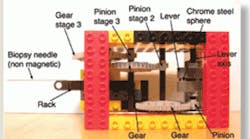Engineers at Children's Hospital Boston have demonstrated the ability to program the magnetic field generated by a clinical MRI scanner to motorize and control a robotic instrument — in this case, a surgical biopsy needle. They presented their findings at the International Conference on Intelligent Robots and Systems 2011 (IROS) sponsored by the Institute of Electrical and Electronics Engineers and the Robotics Society of Japan in San Francisco on September 29. Their paper, “MRI-powered Actuators for Robotic Interventions,” was recognized as one of five finalists for the IROS 2011 Best Paper Award.
“We've demonstrated that MRI, in addition to providing terrific images of soft tissue, can also produce sufficient force to drive a robotic device,” says senior investigator Pierre Dupont, PhD, chief of pediatric cardiac bioengineering. “Our goal is to create magnetically-powered robots that can either travel through the body to perform targeted therapies or reside inside the body as adjustable prosthetic devices.”
Dupont envisions tiny ball-bearing-sized robots that could be steered through the cerebrospinal fluid or the urinary system to deliver drugs or stem cells, and implantable devices that could be adjusted to regulate blood flow in the heart or gradually be enlarged to prevent the need for larger implants as a child grows.
His robotic biopsy device, built from toy LEGOs, has a freely rotating arm that swings in the direction of the magnetic field and a series of gears to convert that motion into the motion of a biopsy needle strong enough to puncture tissue and then withdraw. Apart from a small magnetic sphere inside the arm, located outside the area being imaged, the motor is built from plastics and nonferrous metals that are compatible for use with MRI, as is the biopsy needle itself.
Although MRI-compatible robots have been built, no one had previously created an MRI-powered motor, Dupont says. The team has also demonstrated the ability to have the MRI machine's magnetic field independently control two robots at once, and have also created an MRI-driven locking mechanism for the motor. The next engineering challenge Dupont's lab is tackling is to create swarms of “swimming robots” that could be steered magnetically to different destinations. Each tiny robot, several millimeters in diameter, is designed with unique characteristics to produce variations in its swimming dynamics that influence its direction and speed. Research is funded by the National Institutes of Health, using MRI time provided by Brigham and Women's Hospital.
For more information, visit vectorblog.org.
